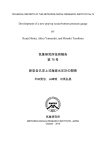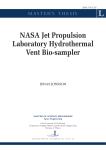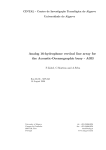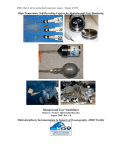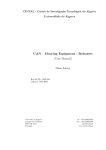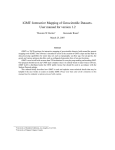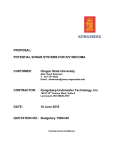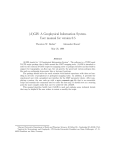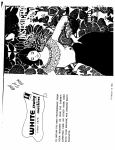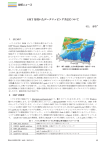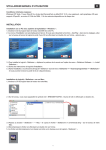Download Mirone: A multi-purpose tool for exploring grid data
Transcript
ARTICLE IN PRESS Computers & Geosciences ] (]]]]) ]]]–]]] www.elsevier.com/locate/cageo Mirone: A multi-purpose tool for exploring grid data$ J.F. Luis CIMA, Universidade do Algarve, Campus de Gambelas, 8000-117 Faro, Portugal Received 15 October 2005; received in revised form 5 May 2006; accepted 26 May 2006 Abstract Mirone is a Windows MATLAB-based framework tool developed by the author that allows the display and manipulation of a large number of grid formats through its interface with the Geospatial Data Abstraction Library (GDAL). Its main purpose is to provide users with an easy-to-use graphical interface to the more popular programs of the Generic Mapping Tools (GMT) package. In addition it offers a range of tools dedicated to topics in the earth sciences, including tools for multibeam mission planning, elastic deformation studies, tsunami propagation modeling, earth magnetic field computations and magnetic Parker inversions, Euler rotations and poles computations, plate tectonic reconstructions, and seismicity and focal mechanism plotting. The high-quality mapping and cartographic capabilities for which GMT is renowned is guaranteed through Mirone’s ability to automatically generate GMT cshell scripts and dos batch files. User-specific requirements that lie outside the current capabilities of Mirone can be met by simple programming to provide the required functionality. r 2006 Elsevier Ltd. All rights reserved. Keywords: Mirone; GMT; Data conversion; Grids; Geomagnetism; Plate tectonics; Geophysics 1. Introduction Mirone is an open source code written in MATLABs 6.5 by the author and has been developed specifically for the purpose of visualizing and manipulating GMT netCDF grids. GMT (Wessel and Smith, 1991) is one of the most popular programs within the scientific community on account of its mapping capabilities and high-quality graphics. However, most commercial software packages ignore this format and products that are able to read GMT, and to display and manipulate $ Code available from server at http://w3.ualg.pt/jluis/ mirone/ Tel.: +351 289 800938; fax: +351 289 818353. E-mail address: [email protected]. 0098-3004/$ - see front matter r 2006 Elsevier Ltd. All rights reserved. doi:10.1016/j.cageo.2006.05.005 GMT grids, are rare. An additional problem that users face concerns data format. There are presently tens of different formats for storing gridded data and imagery data, and accessing data from disparate sources is a common problem. Mirone minimizes this obstacle through its interface with the GDAL (www.gdal.org). GDAL is a unifying C/ C++ API for accessing raster geospatial data released under the MIT Open Source license, which aims to provide efficient access suitable for use in viewer applications, and which attempts to preserve coordinate systems and metadata. MATLAB is a powerful tool for software development. The language is easy to learn and contains a large collection of mathematical functions that facilitate the task of writing complicated code, including Graphical Users Interfaces (GUIs). ARTICLE IN PRESS 2 J.F. Luis / Computers & Geosciences ] (]]]]) ]]]–]]] However, it also has limitations including those of speed and memory consumption. In order to circumvent these constraints, almost all substantial computations involving matrix data in Mirone have been made with the help of external code written in C and compiled as mex files. Because the mex files use scalar programming and employ single precision or short integer variables in circumstances where accuracy is not compromised, their memory consumption is reduced to the minimum necessary whilst the running speed is that of a compiled code. This paper reports the general characteristics of Mirone, and describes and explains the program’s main capabilities and functions. The paper also provides some example applications to topics in the earth sciences including elastic deformation, tsunamis, and plate tectonic motions. Aspects of the future refinement and development of Mirone are also addressed, including an example of how it can be extended by programming for particular needs. The source code and a stand-alone version, which is a version that does not require MATLAB, are available at w3.ualg.pt/jluis/mirone. 2. The program design philosophy Mirone was designed to address many of the specific needs of those who regularly use gridded data, but is particularly focused on the fields of geophysics and earth sciences. It provides comprehensive data visualization and analysis in a userfriendly environment. One of Mirone’s advantages is that the author is also a user. I have found that much graphically oriented software obliges the user to follow a strict procedure that often requires in-depth study of the accompanying manual in order to accomplish even simple display tasks. In Mirone, the user merely loads the grid of interest (assuming that it belongs to one of the recognized formats) and views it. Particular attention has been paid in the program to offer the user the simpler and more often used options first, and to let the more specific options show up only when they may be needed to solve a particular problem. Since Mirone offers a large number of operations, it has been designed in a modular fashion. Options that require input parameters are run from independent windows which, whenever possible, offer ‘‘clever’’ default values. A comprehensive set of ‘‘tooltips’’ and ‘‘helps’’ has been attributed to the buttons and boxes where data have to be entered, in order to facilitate the comprehension of each module’s operation, to the extent that many modules should not require reference to the manual. The modular design can be explored further by users with programming skills, and it is relatively easy to add new possibilities to the main program, as demonstrated in Section 7 below. For the purposes of demonstration or teaching, a number of datasets have been incorporated covering topics such as seismicity, active volcanoes, ODP/ DSDP sites, plate boundaries, major cities, and magnetic isochrons of the world’s oceans. These datasets are not purely static but contain relevant information associated with various items. For example, right clicking on a plate boundary segment informs the user about neighboring plates as well as the opening rate and direction. 3. Starting the program Upon starting the user is presented with Mirone in its basic form, which is a simple bar containing various menus. See Fig. 2 for an example of a Mirone window with data already displayed. Activities are initiated by using these menus. Although Mirone has pre-defined defaults it is very important that the user understand what these defaults mean and do. The first time the program is used the user is strongly advised to press the button with hammers icon. This icon opens the preferences window (Fig. 1). The meanings of those settings are: Use new GMT netCDF grid format . Starting with GMT version 4.1, a new type of COARS-compliant GMT net CDF grids was introduced. While this change is transparent to users, the new grid format will not be recognized by previous GMT versions. Grid coordinates . Select Geographic (default) if working with a grid whose coordinates are longitude and latitude, otherwise select Cartesian. This is an important setting because some operations, such as measuring, depend on the grid coordinate system. Grid Max size . In order to perform grid manipulations, Mirone stores the original grid in the computer’s memory (in single precision). This is the maximum size in Mb that a grid can occupy in the computer’s memory. This does not mean that larger grids/images cannot be processed, it means that if they exceed the size value they will be re-read from disk as required. The user must decide a reasonable value for this parameter based on the capabilities of ARTICLE IN PRESS J.F. Luis / Computers & Geosciences ] (]]]]) ]]]–]]] Fig. 1. Parameter configuration window. the computer being used. Grid size is computed as: n_rows n_columns 4/(1024 1024). (Note: Mirone makes most of its heavy computation using external mex files that use scalar single and double precision arithmetic. However, some operations may be performed with MATLAB operators using imply double precision, which takes twice as much memory. When image files are being used, however, this rule does not apply.) Swath ratio . When performing a multibeam planning, the swath width coverage as a function of the water depth needs to be known. When the first track is started by the user, a question will be made concerning whether the current value is to be used, or whether it should be changed. Measure units . When computing distances, the result is presented in the chosen unit. Available options are nautical miles, kilometers, meters, and user-defined. Default ellipsoid . Mirone computes distances on an ellipsoidal Earth. The list of available ellipsoids include the 63 GMT-supported ellipsoids plus one for Mars, which is needed when working with 3 MOLA grids. Users that whish to set a custom ellipsoid will need to edit the mirone_prefs.m file. Working directory . To reduce the cumbersome task of browsing through the directory tree every time a file needs to be saved, the program uses a default working directory. Either the full path may be typed here, or the side button pressed to select a directory within a new window. New grids in new window . Many options involve the computation of a new grid. This parameter controls whether the newly computed grid is automatically opened in a new Mirone window (if this option is checked) or saved on a disk file. Force insitu transposition . This option helps with the importation of large grids. Importing grids involves a conversion that uses matrix transposition, which requires twice the grid size in memory when a copy is made of the grid to speed importation. The in situ transposition option uses only the grid size in memory and should be used where the computer has insufficient memory, although the importation runs about 10 times more slowly than if the grid is copied. When possible save as int16 . Some grids use short ints (2 bytes) to save disk space. Checking this option means that, if the grid is saved in the GMT format, the 2 bytes original density will be retained (otherwise, it will be saved as floats of 4 bytes). This is useful, for example, to convert Shuttle Radar Topography Mission (SRTM) grids into GMT format. Default line thickness . This default value is used for drawing lines, circles or other graphical elements. Default line color . This default value is used for drawing lines, circles or other graphical elements (such as text strings). For a complete explanation of all options offered by the program the reader is directed to the user’s manual. 4. General functionality By default Mirone automatically detects and reads all types of netCDF GMT grids as well as Surfer 6 and 7 grids. Many of the formats recognized by GDAL may also be accessed through the File menu. Those include: GeoTIFF DEM, DTED, USGS DEM, USGS SDTS DEM, Gtopo30, SRTM DEM, Arc/Infos ascii/binary grids, ENVI, ERDAS. img, GeoTIFF, Grid Exchange File (GXF from Geosofts), Mars Orbiter Laser ARTICLE IN PRESS 4 J.F. Luis / Computers & Geosciences ] (]]]]) ]]]–]]] Altimeter (MOLA) grids, and the common image formats. When the loaded grid is referenced in geographical coordinates it is also possible to plot the netCDF coastlines database (including rivers and political divisions) provided by GMT. These include not only the coastlines themselves but also the rivers and political divisions (country frontiers and US states). The netCDF coastlines database is the only currently available non-ASCII vector format. Other line and point data must be loaded from ASCII disk files containing x,y coordinates, one record per line. Multi-segment files, that is a file where segments are separated by a special record (the ‘4’ character), are also supported. When a grid is loaded the Mirone window expands to accommodate the image derived from the grid. At the bottom of the window the current mouse position is displayed in the grid’s coordinates. Clicking and dragging over the image shows the distance in the selected user units. The generated image uses a default color map, but more than 100 other color palettes are available by clicking on the palette icon button to access the palette tool (not shown here). All palettes may be changed by a double click over the color bar. This inserts color markers, which can be dragged to modify the color map. A second double click deletes the marker. The Min Z and Max Z fields may be used to impose a fixed color map between those values. External GMT color palettes may also be imported or exported via the File menu. Another common operation is to show patterns and fine details in the grid image as revealed by applying a shading illumination. Mirone offers five different algorithms for shading illuminations. By default a mex version of the GMT grdgradient program is used to do this, but the user can select any of the five methods from within the control window. Sun azimuth and elevation (when accepted by the method) are controlled with the mouse. The buttons with T, circle, line, rectangle, closed polygon, and arrow icons permit the user to draw any of these graphical elements (Fig. 2). Those elements may be subsequently edited by doubleclicking the selected target. Besides their use as simple drawings (which may be saved as ascii files) such elements (in particular the polylines, rectangles, and closed polygons) allow other possibilities. A polyline, for example, may be used to measure the distance or azimuths of its individual segments, and it can be also used to extract and show a savable grid profile in much the same way as the grdtrack Fig. 2. Example case: base image was computing by shading illumination of a GMT bathymetry grid. Dark dots represent seismicity as imported from an ISC catalog. Triangles correspond to active volcanoes. Also two logo images were inserted to demonstrate this facility. GMT program. Rectangles may be used to limit the range of one operation to the area delimited by the rectangle. The Crop Image operation is quite common in many programs that display image type files. In Mirone I have extended that concept to other operations. It is thus possible to extract a subregion of a grid, compute histograms and power spectrums, determine autocorrelation, apply median filters, smooth by spline interpolation, fill gaps (holes) in the grid, set all grid nodes to a constant value, and utilize a separate tool, also included in the package, to perform Region Of Interest (ROI) image processing type manipulations. Furthermore, the rectangle’s limits may be used to register an image into another coordinate system. The rectangle corner coordinates are used to compute an affine transformation that registers the image to the rectangle’s coordinate system. The closed polygons also offer the possibility of measuring areas, cropping grids, and performing ROI manipulations. The polygonal cropping differs from the rectangular one in that the grid nodes external to the polygon are set to not a number (NaN). Mirone contains a large collection of both general-purpose operations and discipline specific modules. Among the first group, generally organized inside the Grid Tools menu, the user may find interactive tools to drive a selection of GMT programs, namely: Grdfilter —filters grids in the time domain using one of the selected convolution or non-convolution filters. ARTICLE IN PRESS J.F. Luis / Computers & Geosciences ] (]]]]) ]]]–]]] Grdgradient —computes the directional derivative in a given direction, or the direction (and the magnitude) of the vector gradient of the data. Grdproject —transforms a gridded data set from a rectangular coordinate system into a geographical system (or vice-versa) by resampling the surface at the new nodes. Grdsample —reinterpolates and creates a new grid with either a different registration or a new grid-spacing or number of nodes, and perhaps also a new sub-region. Interpolation is bicubic or bilinear and uses boundary conditions. Grdtrend —fits a low-order polynomial trend to the grid of interest using (optionally weighted) leastsquares. Surface and nearneighbor —interpolates randomly space triplets (x,y,z) into a regular matrix (that can later be saved as a GMT grid). Other options involve computing histograms, clipping a grid above and/or below selected planes, writing a mask grid where non-NaN values are replaced by the number 1, computing spectra and autocorrelations, smoothing grids by spline interpolation, computing slope, aspect, and directional derivatives, and computing a Second Derivative in the direction of Gradient (SDG). The SDG is the algorithm recommended by the United Nations Convention for the Law Of Sea (UNCLOS) to be used in the determination of the Foot Of continental Slope (FOS). The SRTM has obtained elevation data over most of the globe to generate the most complete high-resolution digital topographic database of the planet. It is distributed as 11 DTM tiles of 1 arcsec for the US territories and 3 arcsecs for the rest of the world between 561S and 601N. In areas of high relief, areas covered by water (e.g., rivers, dams, and natural lakes), and at land-ocean transitions, the SRTM models commonly display zones of no-data (grid holes). Although strategies to fill these holes using coarser data (e.g., from the elevation data model GTOPO30) could potentially be used, the coarser resolution may not depict such areas with sufficient accuracy. Therefore, the Mirone solution is simply to offer the user the possibility to fill the holes, which are automatically detected in Mirone, by either minimum curvature or bilinear interpolation. The resulting processed file may be saved in the SRTM format. Given the limited coverage (11 11) of each individual SRTM tile, it is often desirable to be 5 able to create mosaics. Mirone has a dedicated and easy-to-use tool to accomplish this task (Fig. 3). With the SRTM mosaic tool the user first draws a rectangle to define the ROI. By right clicking on the rectangle and choosing mesh , yellow quadrangles corresponding to possible SRTM tiles can be drawn. A mouse-click on each individual quadrangle searches the previously selected working directory for existing SRTM files. The square turns red if the matching file exists, if it does not exist a warning message is displayed and the square returns to yellow. The size of raster datasets grows very quickly. For example, the General Bathymetric Chart of the Oceans (GEBCO) 1 min resolution grid contains 445 Mb of data, but the global mosaic of the SRTM tiles amounts to 1.9 Gb in GeoTIFF DEM format. This means that the majority of computers owned by typical users will probably not be able to process those files at their full resolutions. One way to circumvent this problem, as used by some software packages, is to use complicated algorithms that split the entire dataset (if the data format allows them to) in layers of variable resolution. Mirone approaches the problem of loading data from very large grids somewhat differently. With the File 4open overview tool the user may inspect the contents of a very large grid without loading it. What this tool actually does is to read nother rows and columns in order to obtain an overview grid that is as close as possible to 200 200 rows and columns, and builds a preview image. The user can then draw a rectangular area in order to extract the data at its full resolution. Fig. 3. SRTM mosaic tool showing four successful tile selections and error message displayed when intend SRTM tile could not be found in indicated directory. ARTICLE IN PRESS 6 J.F. Luis / Computers & Geosciences ] (]]]]) ]]]–]]] 5. Discipline-specific tools Mirone contains a range of specific tools for application to topics in geophysics and earth sciences. The list of applications cover multi-beam mission planning, elastic deformation, tsunami modeling; including travel time estimation, plate tectonic reconstructions, Euler rotations and Euler poles computations, magnetic field computations and magnetic inversions, and seismicity and focal mechanism plotting. A selection of these tools is discussed below. 5.1. Elastic deformations The elastic deformation tools are accessible via the Geophysics 4Elastic deformation menu. Here, a line or polyline can be imported or drawn over the image grid. The line is interpreted as the surface trace of a fault. Right clicking on the line allows the user options to open new windows in which can be specified the fault parameters (width, depth, dip) as well as the movement/deformation to be simulated. The two available deformation options are called Okada and Mansinha (Okada, 1985). The Okada tool is more general and can be used to simulate coseismic displacement (that can be compared with GPS measurements) for an initial condition of the far field tsunami modeling (see below) or to compute synthetic interferograms. The Okada window provides help in the form of tooltips when the mouse rests over individual entry boxes. For a complete reference to the use of the Okada window the user should read the RNGCHN program paper (Feigl and Dupre, 1999). In that original paper, the RNGCHN code is provided both as a stand-alone FORTRAN code and as a MATLAB FORTRAN77 mex file. The stand-alone code depends on some C code to deal with input/output but it is system dependent (it runs only on Sun and HP UNIX systems). The mex file, because it is written in F77, has the limitation of not supporting dynamic memory allocation. Mirone uses a C version in which coordinate conversion routines were added. The Mansinha option computes only the vertical component of the deformation produced by an earthquake. The two codes should produce equal results and trials show this to be the case. In both Okada and Mansinha , all distances are computed by projecting the geographical coordinates to Transverse Mercator with the origin being the fault’s first point. Fig. 4 presents an example of using Okada . 5.2. Tsunami modeling Mirone has two codes to perform tsunami modeling of propagation and inundation. The SWAN code (Madder, 2004, rMader Consulting Co) and the TUNAMI-N2 code (Imamura, 1997). Both of these codes were converted from FORTRAN to C to allow dynamic memory allocation. The example presented here uses the SWAN code. To use this program, the user needs to have two grids that are exactly compatible (i.e. they must cover the same region and have the same number of rows and columns). One of the grids represents the bathymetry (z positive up) in meters and the other contains the initial deformation as produced by the Mansinha or Okada deformation module. A required parameter file ‘‘swan.par’’ can be found in the data directory of the root Mirone installation, which can be used as an example for other cases. The user must choose between computing the simulation on specific points, termed ‘‘maregraphs’’ here, and/or on the whole grid region. If the first option is desired, the stations can be plotted graphically (using the Plot Stations option), or the maregraphs’ locations can be imported in an x,y file. If the simulation is to be performed over the whole region, then the Compute option is used. A new window called swan_options will popup where the final selections are made. See the user’s manual for further details on using this tool. Fig. 4. Example of parameter settings used to characterize movement along a fault and to compute elastic deformation produced by that movement. ARTICLE IN PRESS J.F. Luis / Computers & Geosciences ] (]]]]) ]]]–]]] 5.3. IGRF calculator The International Geomagnetic Georeference Field (IGRF) calculator (Fig. 5) is a tool that computes the value of the total magnetic field (or its components) for given points. A single point can be selected either by a mouse click on the world map or by entering its exact coordinates. Alternatively, a file can be read and imported that contains the magnetic data along with longitude and latitude positions. The user has the option of choosing to compute the magnetic anomaly (measured total field minus the IGRF magnitude). Computing the magnetic anomaly requires knowing the date of data acquisition, in which case the file reading function has the ability to decode many date formats, including text formats. The IGRF model used is the 10th generation IGRF as agreed in 7 December 2004 by IAGA Working Group V-MOD. It is valid for dates 1900.0 to 2010.0 inclusive. The IGRF routine (a C mex file) is also used within the Parker Direct and Parker Inversion tools. The first allows the computation of the magnetic anomaly given a magnetization and bathymetry map using Parker’s (1972) Fourier series summation approach. The second performs the inverse operation, which is the computation of the magnetization from magnetic field and bathymetry (Parker and Huestis, 1974). This inversion procedure eliminates the dependency on the shape and amplitude of the magnetic anomalies with the distance between the survey altitude and the seafloor. 5.4. Geographic calculator This tool is an interface to both the mapproject and grdproject programs in GMT. It uses a mex version of these programs and its use is fairly straightforward. GMT version 4 introduced datum conversions in mapproject (but not in grdproject ) and shifts that allow conversion between the many projection systems in use. Currently, only the Portuguese systems are coded in Mirone. Overall, this tool frees GMT users from the need to provide a correct –R for the transformation (potentially particular hard to know in advance in inverse transformations), a problem, which has prevented many users from being able to use grdproject . 5.5. Plate reconstructions Fig. 5. Illustration of IGRF calculator. Points for which geomagnetic field is to be computed can be selected by clicking on image. ‘‘Griding Line Geometry’’ configures grid parameters necessary to compute a grid, e.g., of total field or magnetic declination. This tool lies somewhere between a plate reconstruction demonstration and an application that can be used to do advanced plate motion work. There are some dedicated software packages available on the web that perform plate reconstructions (see for example www.geodynamics.no/gmap/ngu@gmap/ Geodynamics.htm and links therein). However, the Mirone plate reconstructions tool is easy to use and has good functionality. Options can be obtained by right clicking over the plates. New menus pop up (see Fig. 6) from which the user can control how the plates move. By default the program associates a ‘‘movement history’’ to three plates: Iberia, Eurasia, and Africa. The movement is defined by the poles as displayed in the window’s bottom left corner. In addition to the default files, the user can load his/her own data, including poles files and plates files. ARTICLE IN PRESS 8 J.F. Luis / Computers & Geosciences ] (]]]]) ]]]–]]] Fig. 6. Pate reconstruction tool. Reconstructions for particular times are performed using time slider. Example shows position of Iberia, Eurasia, and Africa relative to a fixed North America at 90 Ma ago. The poles used in this program are stage poles (not finite rotation poles). They have a particular format as described in the ‘‘rotconverter’’ GMT program, but example files can be found in Mirone’s ‘‘continents’’ directory. To create new stage poles files from finite rotations poles, Make stage poles is clicked and the ensuing instructions followed. The plates files are simple ascii files with two columns ‘‘longitude’’ and ‘‘latitude’’. The files may be multisegments, with the character ‘‘4’’ serving as the separator. The individual segments may be closed, in which case the contour is filled; otherwise they are drawn as lines. The first line in a file must take the form ‘‘]Name’’, where ‘‘Name’’ is the plate’s name. This allows the program to associate a plate and its companion lines with a stage pole. It also allows other elements (e.g., the 3000 m bathymetric contour) to be added. Mirone contains several other tools to manage plate movements. For example, under the Draw menu the Draw circle 4circle about an Euler pole opens a window where the user can draw an arc circle about Euler poles representing the plate’s present-day movement. Both relative and absolute plate movement options are available. These arc circles also let the user compute the velocity vector (magnitude and direction) at any point along the circle. This is a useful tool for discovering how one plate is moving relative to another at a certain point. The rotation of magnetic isochrons and the creation of flow lines are accomplished using the tool in Geophysics 4euler rotations . Any line element, either drawn or imported from an ascii file or point symbol, may be rotated by using either a stage pole file as described above or a finite rotation pole. When performing rotations with stage poles, an age file that controls the ages for which the rotation is computed is required. For each entry of that age file (displayed in the window’s listbox) a new rotated line is plotted in the Mirone main window. The Magnetic Bar Code button provides an easy way to select an age sequence using the geomagnetic polarity scale as reference. If a single point is selected (using the Pick line from figure button) instead of a line/polyline, then a single flow line is plotted. In the Add poles tab the user may compute the pole that results from a combination of two finite rotations. Users who desire to compute their own Euler poles can do this with the Geophysics 4compute Euler pole tool. To use this tool, two lines in the main window are mouseselected by depressing the Pick line from figure button, and an initial estimate of the Euler pole is entered. The results of the search algorithm are graphically displayed every time a better-fitting pole is found. The process may be rerun using alternative initial estimates of the Euler pole if satisfactory results are not obtained with the initial estimate. 6. 3D view and printing Because Mirone does not use the 3D MATLAB functions, the program does not offer any built-in way of displaying graphics in 3D perspective. Although MATLAB can display in 3D by using its surface primitive, this consumes a lot of memory and has poor interactive response. As an alternative, Mirone uses the IVS Fledermaus free iView3D viewer (www.ivs.unb.ca/products/iview3d). Fledermaus is a fast, powerful 3D visualization tool capable of viewing large amounts of data (Fig. 7). Translations, rotations, and scaling are accomplished by simple mouse controls. For launching the 3D view all is need is to hit the button with the eye icon. By launching the 3D view via the ‘‘eye’’ icon (Fig. 2), a temporary fledermaus object (sd. file) is created and used as an argument for the iView3D call. As an alternative, the user may choose to save the fledermaus object in File 4Save As Fledermaus Objects and later import that object directly from the viewer. Saving the Mirone display can be achieved in three ways. The first is through ARTICLE IN PRESS J.F. Luis / Computers & Geosciences ] (]]]]) ]]]–]]] 9 Fig. 7. 3D view of a bathymetry grid using Fledermaus free iView3D viewer. Light gray cubes represent seismic events. There are more epicenters represented but they are hidden behind current figure display. Changing viewpoint with mouse controls will show them. White line represents coastlines extracted from GMT coastlines database. File 4Save Image As . . . which saves the current display image into one of the common image formats but without including any graphic elements (e.g., lines, symbols). The second way, through File 4Export saves both the image and all elements that may have been added to it in a screen capture. A third possibility involves generating a GMT cshell script or dos batch file. The File 4Save GMT script opens a window (Fig. 8) in which it is possible to fine tune map details such as size, position on the page, and projection system used. This tool searches all elements in the display and decides the best way to reproduce the display using only GMT commands. For example, if the image displayed is derived from a GMT grid illuminated with a shading method from grdgradient , the script lines will generate an illumination grid from the original GMT grid and use ‘‘grdimage’’ with the –I option. If that is not the case then a screen capture is executed and the image saved as three R, G, and B grids. The three grids are then utilized by ‘‘grdimage’’ to rebuild a color image. Line elements are written on disk and used by ‘‘psxy’’. However, coastlines, national borders, Fig. 8. Example of settings used to generate a GMT shell script to plot contents of a Mirone window. Rectangle, which represents map’s size, can be dragged over page or have its limits altered. Any of GMT map projections may be selected. rivers, and contour lines are not saved. Instead, appropriate calls to ‘‘pscoast’’ or ‘‘grdcontour’’ are inserted into the script. ARTICLE IN PRESS J.F. Luis / Computers & Geosciences ] (]]]]) ]]]–]]] 10 7. Evolution of Mirone Mirone is a powerful tool for displaying and analyzing grid and vector data loaded in a variety of formats. The Mirone code comprises more than 90,000 lines of MATLAB code and about 30,000 of C mex code. Due to its modular design, careful programming, and interface to GMT and GDAL libraries, the program is able to read large amounts of data that would otherwise prove impossible if only MATLAB primitives had been used. Currently, however, the GDAL and GMT links are weakly developed. For example, at the moment it is not possible to load any of the satellite image formats recognized by GDAL or to import ECW or MrSid (wavelet-based image compression technologies developed, respectively, by ERMappers and LizardTechs) compressed images. Adding options to do these tasks is not technically difficult to program, but great care will need to be taken owing to the potentially huge size of these types of image files. GMT itself continues to evolve. The developing version 5 will be significantly different from previous versions (although backward compatible). It will be reborn as a true code library that programmers will be able to use with little wrapping code in order to access its full capabilities (P. Wessel, pers. commun., April 15, 2005). A MATLAB compatibility layer is also planned, at which stage Mirone will be able to more fully explore GMT’s capacities. A full range of map projections will also be added. In the meantime adding new options is a relatively straightforward task. I give a simple example on how Mirone can be extended to perform another operation, in this case to add a menu entry that allows a grid to be flipped upside-down. The first step is to decide where the new entry will be added: in the GridTools menu after the Write mask option is appropriate. The menus are declared in the mirone_uis.m file. Searching this file for Write mask reveals lines that read: uimenuð‘Parent’; h278; . . . ‘Callback’; ‘mironeð‘‘GridToolsGridMask_Callback’’; gcbo; ½; guidataðgcboÞÞ’; . . . ‘Label’; ‘Write Mask’; ‘Tag’; ‘GridToolsGridMask’Þ; A new uimenu call and a new callback name function are declared, here denoted ‘‘GridToolsFlipUD_Callback’’ uimenuð‘Parent’; h278; . . . ‘Callback’; ‘mironeð‘‘GridToolsFlipUD_Callback’’; gcbo; ½; guidataðgcboÞÞ’; . . . ‘Label’; ‘Flip Up; Down’; Tag’; ‘GridToolsFlipUD’Þ; Now a new callback function is added to the mirone.m file, and programmed. It would look something like (without error checking): function ‘GridToolsFlipUD_CallbackðhObject; eventdata; handlesÞ % retrieve the arrays stored in figure’s appdata ½X; Y; Z; head ¼ load_grdðhandlesÞ; % Flip the grid array Up Down Z ¼ flipudðZÞ; % Save back the flipped array for future use setappdataðhandles:figure1; ‘dem_z’; ZÞ; % Get the image handle h_img ¼ findobjðhandles:figure1; ‘Type’; ‘image’Þ; % Flip also the displayed image setðh_img; ‘CData’; flipdimðgetðh_img; ‘CData’Þ; 1ÞÞ ARTICLE IN PRESS J.F. Luis / Computers & Geosciences ] (]]]]) ]]]–]]] A final aspect of Mirone’s evolution regards its portability to other operating systems. In its current form, despite the fact that it is written in MATLAB, Mirone runs only in Windows. This is a consequence of using many compiled C mex files that are either self-contained or make calls to the GDAL and GMT libraries. To port Mirone to Unix/Linux or Mac Os X, all that must be done, in principle, is to recompile all such mex files under the specific OS. Acknowledgements Maurice Tivey for giving permission to use his Parker inversion routines. MATLAB contributors to file exchange from which many ideas were taken. This paper and many improvements to the code were written during the author’s sabbatical year. This work was supported by the STRIPAREA— POCI/CTE-GIN/59653/2004 project. 11 References Feigl, K.L., Dupre, E., 1999. RNGCHN: a program to calculate displacement components from dislocations in an elastic halfspace with applications for modeling geodetic measurements of crustal deformation. Computers & Geosciences 25 (6), 695–704. Imamura, F., 1997. Numerical Method of Tsunami Numerical Simulation with Leap-Frog Scheme. Time Project. IUGG/ IOC, UNESCO, Paris. Madder, 2004. Numerical Modeling of Water Waves, Second ed. CRC Press, Boca Raton, FL, 288pp. Okada, Y., 1985. Surface deformation to shear and tensile faults in a half-space. Bulletin of the Seismological Society of America 75 (4), 1135–1154. Parker, R.L., 1972. The rapid calculation of potential anomalies. Geophysical Journal of the Royal Astronomical Society 31, 447–455. Parker, R.L., Huestis, S.P., 1974. The inversion of magnetic anomalies in the presence of topography. Journal of Geophysical Research 79, 1587–1593. Wessel, P., Smith, W.H.F., 1991. Free software helps map and display data, EOS. Transactions of the American Geophysical Union 72 (41), 441.












